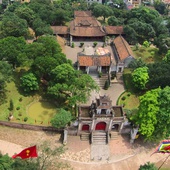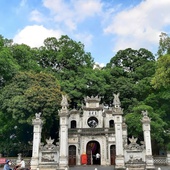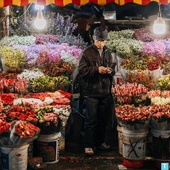Long Bien Bridge
“Hanoi” - meaning “surrounded by river” - is a city renowned for its ponds, lakes, rivers, and bridges. The iconic Hoan Kiem Lake, with its vibrant green waters and the charming red bridge known as The Huc, symbolizes the elegance and charm of this ancient city. Meanwhile, the Red River and Long Bien Bridge stand as tributes to the resilient spirit of the capital, especially during times of war.
History
The Long Bien Bridge was constructed between 1899 and 1902 during the French colonial period. Although designed by French engineers, it was built by Vietnamese workers using local materials, including wood from Phu Tho, Yen Bai, and Thanh Hoa provinces, along with cement sourced from Hai Phong and lime from Hue.
Initially named the Paul Doumer Bridge by the French, it has been popularly referred to as Long Bien or Cai River Bridge among locals for years. Originally comprising 19 spans, it was the first steel bridge to cross the Red River in Hanoi and was celebrated as one of the four greatest bridges globally upon its completion.
Long Bien Bridge is an architectural pride and a symbol of resilience in Southeast Asia. It played a crucial role in transporting vast quantities of rice from Northern and Northern Central Vietnam to the Dien Bien Phu battlefield, significantly contributing to the victory of the Vietnamese forces over the French in 1954.
Over its century-long existence, Long Bien has weathered numerous challenges, including repeated American airstrikes during the Vietnam War in 1967 and 1972, which resulted in the destruction of several of its spans. The surviving sections of the bridge serve as poignant reminders of the past, making it not just a functional passageway, but also a living historical monument.
What to See
Today, Long Bien Bridge is one of five bridges traversing the Red River in Hanoi, yet it remains the most distinct due to its rich history, architectural significance, and cultural value. Unique to Hanoi, all traffic on the bridge must keep to the left side, allowing pedestrians to stroll and sample delectable desserts from local vendors. Visitors are encouraged to check out five street vendors you shouldn’t miss in Hanoi or stop by the small afternoon market on the bridge to purchase fresh vegetables or fish.
Many locals and visitors consider Long Bien Bridge the ideal spot for witnessing sunrises and sunsets, making it a favored photography location for young couples, especially during wedding shoots. Tourists often venture here to appreciate the blend of historical architecture and stunning natural views, while many residents frequent the bridge to enjoy the evening market atmosphere.
Additionally, trains continue to pass over the bridge daily, adding to its vibrancy. Long Bien - Hanoi's oldest bridge - thus remains an integral part of daily life in the city. If you find yourself in Hanoi, don’t miss the chance to wander along Long Bien Bridge, soaking in the everyday rhythms of life while pondering its remarkable history.
How to Get There
You can either rent a motorbike (remember to keep to the left side) or take a leisurely walk from Central Hanoi to Long Bien Bridge, located just over 1 km from the Old Quarter.
For accommodation options, check out the full list of hotels in Hanoi.
Useful Information
- Location: Long Bien Bridge
- Best for: Solo, Couple
- Entrance: Free
- Hours: All Day
- Distance to city center: 3.2km (2.0 mi)

Co Loa Citadel
Being a cultural heritage, a testament to the creativity and technical skills of the old Vietnamese, Co Loa Citadel is definitely an ideal tourist destination that visitors cannot ignore when visiting Hanoi.

Quan Thanh Temple
Located on Thanh Nien Street, Quan Thanh Ward, Ba Dinh District, Hanoi, Quan Thanh Temple is a Taoist temple and known as one of Hanoi’s four sacred temples which were built to worship four protectors in four directions.

Quang Ba Flower Market
Without the normal hustle and bustle of normal markets, Quang Ba Flower Market is charming in its own way.








